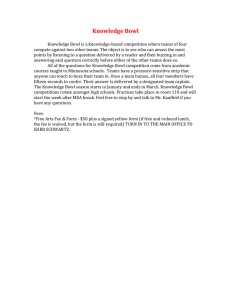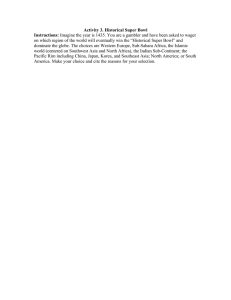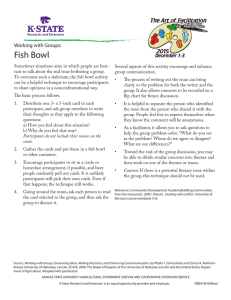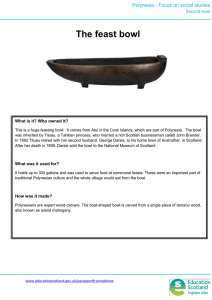Maintenance Information Manual, Pneumatic Filters, Regulators
advertisement
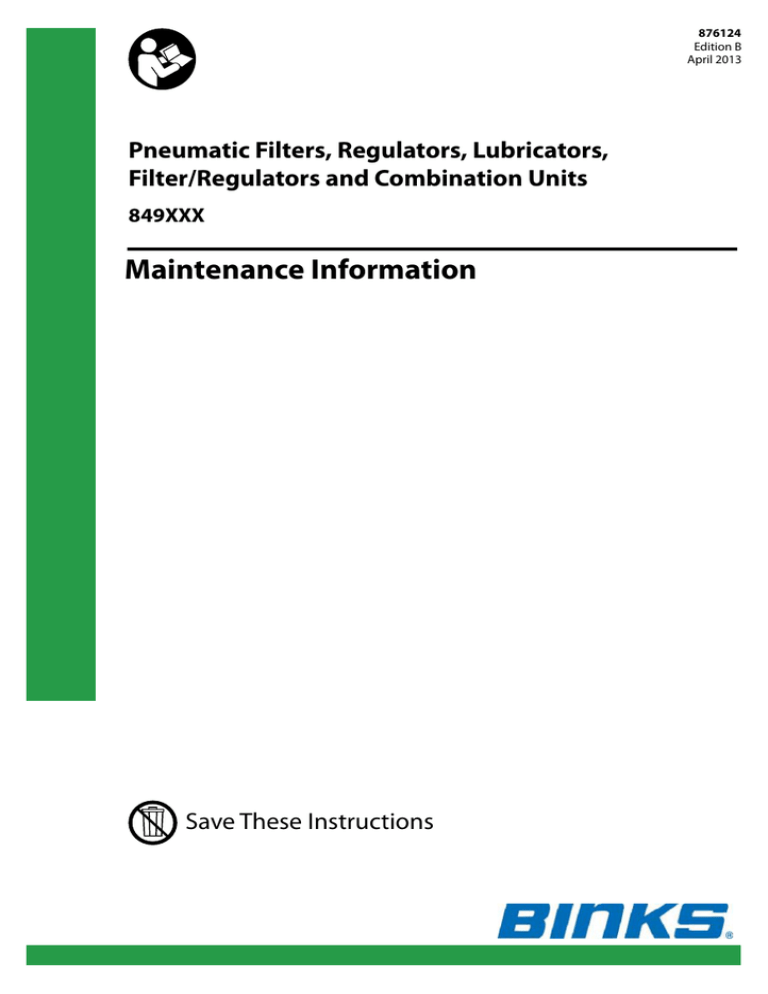
876124 Edition B April 2013 Pneumatic Filters, Regulators, Lubricators, Filter/Regulators and Combination Units 849XXX Maintenance Information Save These Instructions Product Description The air line Filters, Regulators, Lubricators, Filter/Regulators and Combination Units are intended for use in industrial compressed air systems only. No other use is recommended. Filters ARO compressed air filters are designed to remove airborne solid and liquid contaminant’s which may plug small orifices and hinder performance, or cause excessive wear and premature equipment failure. Several filter elements are offered, including models with coalescing elements for removal of oil aerosols and particles down to 0.3 micron. Regulators ARO air line regulators provide controlled, consistent air pressure as required for specific pneumatic equipment connected to the air system. Standard relieving-type regulators are offered in a variety of adjustable pressure ranges, with convenient spring options for easy conversion should requirements change. Non-relieving models are also offered for applications where the venting of downstream overpressure is undesirable. Lubricators ARO fog-type lubricators help ensure that pneumatic devices receive the required lubrication to maintain operating performance, reduce wear and prolong service life. They are designed to provide the correct amount of oil required for most general applications in a pneumatic system, delivering a constant ratio of oil to CFM. Precise oil feed adjustment allows the proper oil delivery rate. Lubricators should be installed close to the downstream application to ensure effective distribution of oil to the pneumatic components. Filter/Regulators ARO compressed air filter/regulators are designed to remove airborne solid and liquid contaminant’s which may plug small orifices and hinder performance, or cause excessive wear and premature equipment failure. Several filter elements are offered, including models with coalescing elements for removal of oil aerosols and particles down to 0.3 micron. In addition to filtration the regulators portion provides controlled, consistent air pressure as required for specific pneumatic equipment connected to the air system. Standard relieving-type regulators are offered in a variety of adjustable pressure ranges, with convenient spring options for easy conversion should requirements change. Non-relieving models are also offered for applications where the venting of downstream overpressure is undesirable. Combination Units ARO combination units are an assembled version of a filter, regulator and lubricator or a filter/regulator and lubricator. See Product Descriptions above for individual descriptions of components. Product Specifications Flows (scfm) [dm³/s] Series 849XXX Size 1/2” Filter (& Coalescing) 194 (181) [92 (85)] Regulator 215 [101] Lubricator 156 [74] Piggyback 165 [78] Filter: Air Flow is at 90 psig (6.2 bar) inlet and 10 psig (0.7 bar) pressure drop. Lubricator: Air Flow is at 90 psig (6.2 bar) inlet and 7 psig (0.5 bar) pressure drop. Regulator & Piggyback: Air Flow is at 100 psig (6.9 bar) inlet, 90 psig (6.2 bar) set pressure and 33 psig (2.3 bar) pressure drop. Bowl Capacity (oz) [mL] Filter (& Coalescing) and Piggyback Metal 2.4 [72] Lubricator Metal 3.7 [110] Temperature Range Maximum Pressure 23° F - 140° F (-5° C - 60° C) 250 psi (17.2 bar) WARNING General Product Safety Information • • • • • • • • • Read and understand this manual before operating this product. It is your responsibility to make this safety information available to others that will operate this product. Failure to observe the following warnings could result in injury. The Units must not be used with fluids, other than air, for nonindustrial applications, or for life support systems. Always install, operate, inspect and maintain this product in accordance with all applicable standards and regulations (local, state, country, federal, etc.). Filters, regulators, lubricators and filter/regulators contain high pressure air. Always wear eye protection when operating or performing maintenance of these units. Only Service Technicians that are qualified to work on pressurized pneumatic systems should install, maintain or repair this system. Always turn off the air supply and disconnect the air supply hose before installing, removing or adjusting any accessory on this product or before performing any maintenance on this product. Note: When reading the instructions, refer to exploded diagrams in parts Information Manuals when applicable (see under Related Documentation for form numbers). 876124_edB General Installation of Units • Install in an accessible location where product is safe from damage or puncture. • Do not expose this product to direct sunlight, radiant heat, heavy vibration, shock, corrosive gases, chemicals, vapors from organic solvents, water, salt water or steam. • Product that contains bowls need to be securely locked into position noted by the “Lock” and “Unlock” symbols on the bowls and bases of the units. • Be sure all hoses, accessories and fittings are the correct size, are tightly secured and rated above the maximum compressed air inlet pressure. • Ensure an accessible emergency shut off valve has been installed in the air supply line, and make others aware of the location. • Install Filter, Regulator then Lubricator or Filter/Regulator and Lubricator with air flow in direction of arrows located on product. • All maintenance instructions must be followed to ensure proper and safe system operation. • Always wear eye protection when operating or performing maintenance on this product. WARNING • Do not exceed the maximum rated temperature or maximum rated pressure for the product. That may result in hazardous situations including rupture of fittings, hoses, bowls or other parts of the system. • Do not remove any labels. Replace any damaged labels. • Never use a damaged or malfunctioning product or accessory. • Do not modify this product, safety devices, or accessories. • Always turn off the air supply and bleed the air pressure before performing any maintenance on the system. • Do not use this product for purposes other than those recommended. • Use only accessories recommended by Binks. NOTICE • Do not disassemble the unit any further than necessary to replace or repair damaged parts. • Do not remove any part which is a press fit in or on a subassembly unless the removal of that part is necessary for repairs or replacement. • Do not disassemble the unit unless you have a complete set of new gaskets and seals for replacement. Installation – Filters • • • • • • • Install filter with the air flow as indicated by the arrow on the unit. Install filter as close as possible to the air operated equipment for best performance. Filter must be installed with the bowl downward for proper operation. Locate the filter upstream from the regulator and lubricator. When using filter featuring the sight glass on the bowl, orient the bowl so it is most visible for the operator. Air line piping should be the same size as filter ports. Locate filter in air line upstream of cycling directional control valves, and away from any heat source. If used as a main filter, install as close as possible to the air supply. • Use pipe thread sealant on male threads only when connecting piping. Do not allow sealant to enter the interior of the filter. • For maximum coalescing element life and efficiency, install a general purpose filter with a 5-micron element upstream from the coalescing filter. • Connect flexible tubing with 1/8” minimum I.D. to the automatic drain connection (1/8” NPT). Avoid restrictions in the drain line. Operation – Filters • Monitor the sediment accumulation. • If the pressure drop across the filter becomes excessive, empty the filter bowl, replace the filter element to assure good performance. • Soak the filter bowl and clean with soap and water. Refer to warnings concerning polycarbonate bowls. Maintenance – Filters Filter Elements: 1. Depressurize Unit. 2. Remove Bowl/Bowl Guard Assembly by: Polycarbonate Bowl/Bowl Guard Assemblies – Firmly grasp the bowl assembly and pull down on the locking tab while pushing the bowl in an upward direction and turning counterclockwise 1/8 of a turn. The “Lock Position Arrow” should now be in-line with the “Unlocked” symbol. Slowly pull down on the bowl assembly. Metal Bowl Assemblies – Firmly grasp the bowl assembly and push the bowl in an upward direction while turning counterclockwise. The “Lock Position Arrow” should now be in-line with the “Unlocked” symbol. Slowly pull down on the bowl assembly. 3. Remove Baffle located at the bottom of the filter element. 4. Install new filter element. 5. Reassemble in reverse order. 6. Before returning unit to service, insure that all seals have been installed or replaced properly and the bowl is in the locked position. Maintenance – Filters Service Indicator: 1. Do NOT perform any maintenance on the service indicators. 2. Replace defective unit with a new unit. Automatic Drain and Manual Drain: 1. Do NOT perform any maintenance on the Automatic Drains or Manual Drains. 2. Replace defective unit with a new unit. 876124_edB NOTICE • Wash bowl only with soap and warm water. • Filters with manual drain must be drained as frequently as necessary to keep the liquid level below the baffle, which could cause liquid to be carried downstream. Replace filter element if necessary. • Automatic drains can be operated manually by depressing the needle inside drain outlet. • Collect water/oil from filter bowl and dispose of properly. • Replace element when pressure drop reaches or exceeds 10 psig (0.7 bar) or when service life indicator shows approximately one-half red / green. An excessive pressure drop across a saturated but uncontaminated element could indicate operation above the maximum flow rate (see Specifications). • Inspect and replace any parts found to be worn or damaged. Regulators Installation – Regulators • • • • • • • Install regulator with the air flow as indicated by the arrow on the unit. Install regulator as close as possible to the air operated equipment for best performance. Locate the regulator upstream from the lubricator. Mount with the knob up or down on regulator. If the air line contains water, sludge or foreign materials, a filter should be installed on the upstream side to protect the regulator. A tamper resistant feature is available to lock in specific air requirements. After a regulator has been installed in the air line, the adjustment knob should be turned counterclockwise until compression is released from the pressure control spring. This prevents over pressurizing the air operated equipment when the air supply is turned on. • Connect piping to proper ports using pipe thread sealant on male threads only. Do not allow sealant to enter interior of regulator. • Air line piping should be the same size as regulator ports. Operation – Regulators • • • Pull knob to adjust air pressure. Turn clockwise to increase pressure. Turn counterclockwise to decrease pressure. Note: On non-relieving models only, reduce pressure to lower than estimated final operating pressure, purge air (open or actuate air operated equipment to relieve pressure), adjust pressure upward as needed. • Push down to lock knob. Maintenance – Regulators Diaphragm Assembly: 1. Depressurize Unit. 2. Disengage the handle (adjustment knob) lock by pulling the handle upward. 3. Turn pressure adjustment knob counterclockwise until the compression is released from the adjusting spring. 4. Unscrew the Bonnet and remove the Control Spring, Adjusting Assembly and the Diaphragm Assembly. 5. Inspect parts for wear and/or damage. If replacement is necessary, use parts from Service Kit. 6. Reassemble in reverse order. R-Valve Assembly: 1. Depressurize Unit 2. Remove Valve Guide by turning 1/8 turn in counterclockwise direction and pulling outwards. 3. Remove Valve Spring and R-Valve Assembly from Body housing. 4. Inspect parts for wear and/or damage. If replacement is necessary, use parts from Service Kit. 5. Reassemble in reverse order. NOTICE • • • • Clean other parts using soap and warm water. Do not submerge Handle (adjustment knob), Bonnet or R-Valve in cleaning solution as lubricant will be removed. Dry parts and blow out internal passages in body using dry compressed air. Inspect and replace any parts found to be worn or damaged. 876124_edB Lubricators Installation – Lubricators • • • • • • • Install lubricator with the air flow as indicated by the arrow on the unit. Install lubricator as close as possible to the air operated equipment for best performance. Lubricator must be installed with the bowl downward for proper operation. Locate the lubricator downstream from the regulator and filter. When using lubricators featuring the sight glass on the bowl, orient the bowl so it is most visible for the operator. Connect piping to proper ports using pipe sealant on male threads only. Do not allow sealant to enter interior of lubricator. Air line piping should be the same size as lubricator ports. Operation – Lubricators • Use a good grade of non-detergent oil (IR part # 29665) for use in the air operated equipment. Refer to the air operated equipment operator’s manual. Note: This lubricator uses a ball check valve located in the lubricator body to restrict the operating pressure to the bowl and allow removal of the fill plug. This will permit filling or lubricator bowl removal while in the normal operating mode. • Observe the markings (-,+) on the lubricator body which show direction. Turn the adjustment screw counterclockwise to increase and clockwise to decrease. Lubricator Adjustment: Note: This is a siphon type lubricator design, adjustments need to be made with a constant rate of flow thru the lubricator in an operating mode. • Use a small screwdriver to adjust the drip rate. The adjustment screw is located in the sight feed cap on the top of the lubricator. • Determine the average rate of flow (SCFM) thru the lubricator, then turn the adjustment screw to obtain one drop per minute for each 10 SCFM. Example: If the average flow is 20 SCFM, set the drip rate at 2 drops per minute. Note: The fill plug must be removed to allow removal of the lubricator bowl or filling of the unit. • Remove the fill plug carefully. • Fill to the top of the bowl. Maintenance – Lubricators Sight Dome Assembly: 1. Depressurize Unit. 2. Remove Upper Cover from Body 3. Remove Sight Dome Housing (nut). 4. Inspect parts for wear and/or damage. If replacement is necessary, use parts from Service Kit. 5. Clean parts and reassemble in reverse order. Damper Guide Assembly: 1. Depressurize Unit. 2. Remove Bowl/Bowl Guard Assembly by: Polycarbonate Bowl/Bowl Guard Assemblies – Firmly grasp the bowl assembly and pull down on the locking tab while pushing the bowl in an upward direction and turning counterclockwise 1/8 of a turn. The “Lock Position Arrow” should now be in-line with the “Unlocked” symbol. Slowly pull down on the bowl assembly. Metal Bowl Assemblies – Firmly grasp the bowl assembly and push the bowl in an upward direction while turning counterclockwise. The “Lock Position Arrow” should now be in-line with the “Unlocked” symbol. Slowly pull down on the bowl assembly. 3. Remove Damper Guide Screws (3). 4. Clean parts and reassemble in reverse order. 5. Before returning unit to service, insure that all seals have been installed or replaced properly and the bowl is in the locked position. WARNING BOWL REMOVAL HAZARD THE BOWL MUST BE SECURELY LOCKED INTO POSITION BEFORE EXPOSING THE UNIT TO THE LINE PRESSURE. The bowls are designed with a feature which inhibits removal while under pressure. When reinstalling, push the bowl up into the body and rotate to the right 1/8 turn. Failure to lock bowl could cause it to blow off, which could result in personal injury or property damage. NOTICE • Wash bowl only with soap and warm water. • Collect oil from lubricator bowl and dispose of properly. • Inspect and replace any parts found to be worn or damaged. 876124_edB Product Parts Information CAUTION The use of other than genuine Binks replacement parts may result in safety hazards, decreased product performance, and increased maintenance, and may invalidate all warranties. Repairs should be made only by authorized trained personnel. Consult your nearest Binks Authorized Service Center. The original language of this manual is English. Refer all communications to the nearest Binks Office or Distributor. Related Documentation For additional information refer to: Product Safety Information Manual 876122. Parts Information Manuals: 876125 Filter/Regulators Manuals can be downloaded from www.binks.com. 876124_edB Notes: Part Number: 876124 U.S.A. / Canada Customer Service Toll Free Customer Service 195 Internationale Blvd and Technical Support Glendale Heights, IL 60139 800-992-4657 Tel. 630-237-5000 Toll Free Fax Fax. 630-237-5011 888-246-5732
